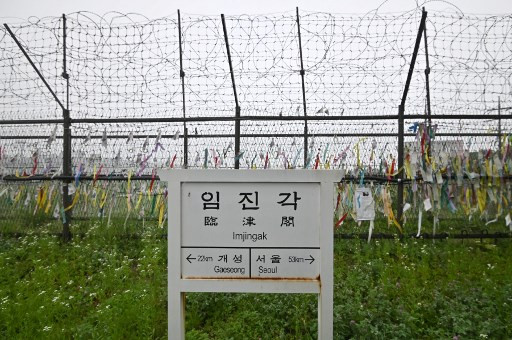Popular Reads
Top Results
Can't find what you're looking for?
View all search resultsPopular Reads
Top Results
Can't find what you're looking for?
View all search resultsHoliday homes and battlefields: Legacies of the Korean War along DMZ
Change text size
Gift Premium Articles
to Anyone
 A sign showing the distance to North Korea's Kaesong city and South Korea's capital Seoul is seen in front of a military fence decorated with ribbons wishing for peace and reunification of the Korean Peninsula at Imjingak peace park in the border city of Paju on June 24, 2020. - North Korean leader Kim Jong Un has suspended plans for military action against the South, state media reported on June 24 in an apparent sudden dialling-down of tensions after Pyongyang blew up a liaison office. (AFP/Jung Yeon-je)
A sign showing the distance to North Korea's Kaesong city and South Korea's capital Seoul is seen in front of a military fence decorated with ribbons wishing for peace and reunification of the Korean Peninsula at Imjingak peace park in the border city of Paju on June 24, 2020. - North Korean leader Kim Jong Un has suspended plans for military action against the South, state media reported on June 24 in an apparent sudden dialling-down of tensions after Pyongyang blew up a liaison office. (AFP/Jung Yeon-je)
F
rom North Korean party headquarters to holiday homes to cemeteries, 70 years after the Korean War began its legacies line the Demilitarized Zone that marks where the fighting came to a standstill.
A few kilometers from the DMZ's eastern end, a small stone villa stands on a cliff overlooking the white sands of Hwajinpo Beach in Goseong, South Korea.
It lay in the North's territory before the outbreak of war, when it was the summer home of its founder Kim Il Sung, grandfather of current leader Kim Jong Un.
Next to the stony steps leading up to the villa -- now a museum -- is a reprint of a faded 1948 black-and-white photo showing five children, among them Kim Jong Un's father and predecessor Kim Jong Il.
Goseong county, along with a swathe of what is now South Korea's Gangwon province, is north of the 38th parallel line of latitude where the US and Soviet Union divided the peninsula after Japan's surrender ended the Second World War and its colonial rule over Korea.
Surrounded by mountain ridges, the peaceful farming village of Haean was the site of some of the most fierce and bloody battles of the war, nicknamed the "Punchbowl" by a US war correspondent who said the area resembled a cocktail glass.
"The South Korean and UN forces had to cross our village in order to advance northwards," explained tour guide and villager Lee Byeong-deuk.
Pointing to a faint North Korean mountain top in the distance, Lee, who was born and grew up in Haean, said his hometown was also used for propaganda: a 1970s government housing project combined every two homes into one to make them look larger -- all of them facing north.
Cheorwon county, 60 kilometers north of the 38th parallel, also changed hands after the 1950-53 conflict ended with an armistice.
On a nearly empty road leading to a military checkpoint stands the concrete shell of a three-story building -- once the regional headquarters for the North's ruling Workers' Party.
"Where we are standing now used to be North Korea," said tour guide Gim Yong-sun.
Before the war, she said, the building was a site for questioning and torturing those accused of anti-communist activities.
Now the tank treads left at the entrance by advancing South Korean and UN forces in October 1950 serve as a reminder of the brutality of a conflict that killed millions.
Barbed wire fence
Hundreds of North Korean troops who never made it home lie in a field outside Paju, the only cemetery in the South for enemy combatants.
Many of the graves hold multiple remains, their simple granite markers saying only the number of they contain, and just a handful are named.
At Panmunjom, the truce village in the DMZ with its emblematic blue huts, their successors on both sides come face-to-face.
In recent years it has seen a series of summits bringing together the North's Kim, the South's President Moon Jae-in, and US President Donald Trump.
But the armistice has never been replaced by a peace treaty, leaving the peninsula technically still at war, and inter-Korean relations are now in the deep freeze with nuclear negotiations between Pyongyang and Washington at a deadlock.
At the western end of the DMZ, barbed wire fences surround the border island of Gyodong, less than five kilometers from North Korea.
Barber Ji Gwang-sik was 13 when he fled Yonpek, his North Korean hometown, at the height of the conflict.
It took "less than 30 minutes" for his family to travel across on a wooden boat, Ji told AFP, but for nearly 70 years he has been unable to return -- even though he can still see Yonpek from Gyodong.
Now 82, he still waits for the day he will be able to return.
"Only those who had the same experience understand the pain," he said.









